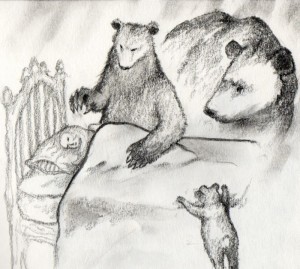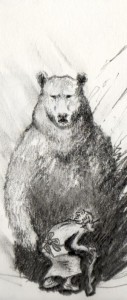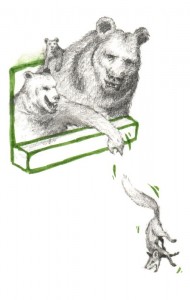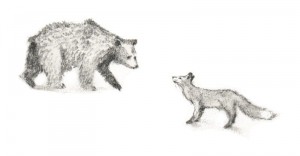Check this out… sound familiar?
Once upon a time there was a mummy bear, a daddy bear and a baby bear, right? Not really. Once upon a time there was a fox…
I’ve never really been a fan of Goldilocks. It always seemed as sickly as Mummy Bear’s porridge. Goldilocks herself was the problem. She was too much the spoiled Victorian brat. Even as a morality tale it seemed a bit flat – Goldilocks escaped unscathed at the end of her trip to the bears’ cottage. There were vague threats about not stealing and tresspassing, but they weren’t backed up at the end of the story. Because of these things I never really investigated the tale’s history. Then I had the urge to draw some quasi-human bears, and it made me look a little deeper.
As you might expect, Goldilocks herself is a reasonably recent invention, her gold hair the most recent tweak of all. Not so long ago she was Silverlocks, and not so long before that she wasn’t even a little girl. She was a hideous and foul old hag, who the bears would have been quite right to tear limb-from-limb. The bears themselves were not a family, but three pals of differing sizes and appetites. This earliest version of the story was apparently recorded (perhaps even authored) by a Victorian gent called Robert Southey. In this version, the central character of the story (the hag) is undoubtedly bad. Bears good, hag bad.
But there’s an older version, Scrapefoot, which is different still. The central character is a fox, and he isn’t a bad fox, he’s just a folklore fox. Folklore foxes are the classic trickster figures, maybe a bit like Coyote in Native American traditions, not bad or good but charmingly mischevious. The French stories about Reynard the Fox are a good example of this kind of character. In Reynard the Fox, the eponymous hero generally causes trouble for kings and barons, pinching their money and so on. This might seem incredibly tangential, but there’s an argument that the Robin Hood legends are an offshoot of Reynard the Fox: the woodland trickster hero of the poor folk, outsmarting and upsetting the rich landowners.
I think it’s important that the bears in Scrapefoot don’t live in a cottage, but a castle. They’re big and powerful creatures with wealth as well as physical power. Simply because of these changes to the way we picture the story, Scrapefoot becomes the underdog (I apologise for the terrible half-pun there) and the bears are no longer honest humble folk but an elite. It’s an interesting counterpoint to the popular version we’ve ended up with on our children’s bookshelves.
As a treat to yourself, take a look at these two clips of Ladislas Starevitch’s stop-motion verson of Reynard the Fox. Le Roman de Renard, one of the first ever animated films. I would kill to get the whole thing on DVD, but I’m afraid it seems to be out of print. Enjoy!





I really like the relation of the characters to the book. Someone should go down that route with a modern animation. You could have the book as part of the story as well rather than simply as a means of telling it. Hmmm…
Those clips are stunning. Let me know if you ever do track it down. 3 minutes of 80 year old footage and yet far more entertaining than mainstream animated cinema today could ever hope to be.
The facial expressions on the King Lion are great!
If I track it down I will certainly let you know. I just hope that I manage to! And I agree that the interaction with the book is fabulous. For such early animation, the way that the animals emerge from each opening page is incredible.
Everyone seems to like these, so I’ll try to find clips of some other stop motion gems from nearly a century ago, and insert them into future posts.
Anything for an excuse to talk about Harryhausen…